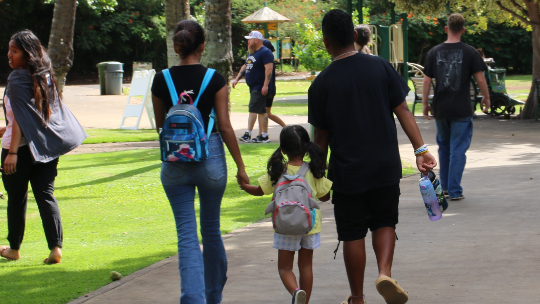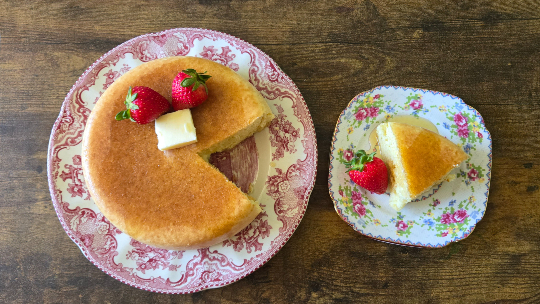There’s a giant pine tree in my parents’ backyard that I called “The King” when I was a child. It towered over the yard and served as our safety area when we played tag.
“The King” inspired me to write about how great trees were in my third grade English class, when we learned about persuasive writing. As an 8-year-old, my rationale for tree superiority was simple: you can build treehouses and view foliage in the fall, and the branches provide homes for animals and shade for picnics.
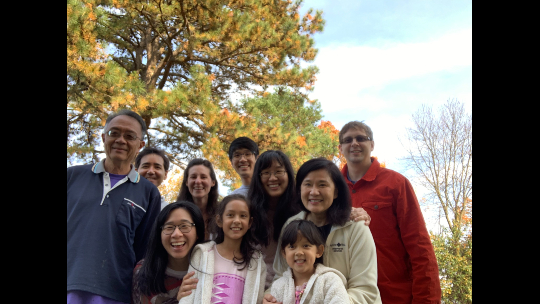
Family photo from a few years ago with "The King" behind us.
At a tree planting event in Waianae, I learned there’s a lot more that trees can offer. From their canopy to beautifying the landscape, cleaning the air, and cooling the city, trees can improve mental and physical health.
That’s the goal of 28 newly planted trees, which now line Maili Community Park. While they’re still relatively small, these trees will soon provide some much needed shade and health benefits to Oahu’s Leeward Coast, which is generally dry and sunny.
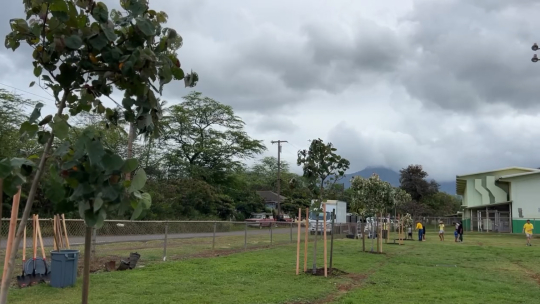
Some of the newly planted trees at Maili Community Park.
“It’s part of the Leeward Cooling Project. These are great shade trees and relatively low maintenance,” explains Navin Tagore, community forester with the City and County of Honolulu Division of Urban Forestry. “We wanted to start here, next to Maili Elementary School, since students play in this park every day for recess. They deserve shade.”
The added trees won’t impact the park’s large field for activities, but they will provide shade for sports fans watching games on the sidelines and keiki who need a break from running around.
“When you have a lot of greenery, you’ll spend more time outside. Trees and shade invite recreation and improve physical and mental health,” says Tagore. “We want people to enjoy our parks and be out in nature.”
Get your hands dirty
The Leeward Coast is one of the hottest spots on Oahu. But the City and County of Honolulu is trying to change that through its Climate Adaptation Strategy by hosting community events with hands-on learning.
During last month’s tree planting at Maili Community Park, volunteers and elementary and high school students got their hands dirty by digging holes and planting the trees.
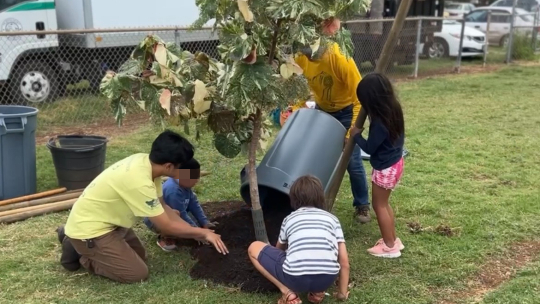
Keiki helped plant trees at the event.
“It connects the students and community to the aina,” says Tagore. “Soil is an antidepressant. It’s great for our body and minds. And by getting the younger generation directly involved with planting trees in their community, they’re taking kuleana over the trees. Because of that shared stewardship, these trees are more likely to survive and be cared for.”
Local nonprofit organizations were also on hand, educating the community on environmental issues affecting Hawaii. Among them are invasive species, including the coconut rhinoceros beetle, which is destroying palm species, especially coconut trees. Niu Now demonstrated how to place netting on the trees, which can entangle the beetles and prevent them from accessing the crown of the palm.
Other booths featured sustainable, DIY planting pots made out of cardboard; making native seed bombs for land restoration; and sharing knowledge on how to plant trees on personal property.
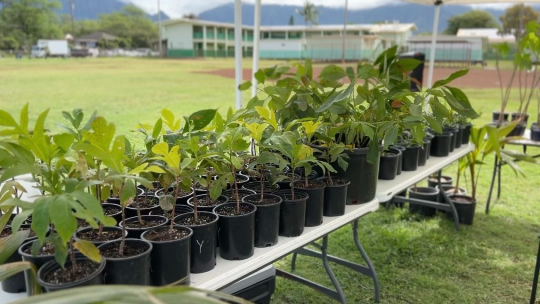
Ulu and avocado trees were among those being given away.
“We’re encouraging the community to not only get engaged with planting, but also how to get more involved with the aina,” says Tagore. “There are certain trees that we can’t plant on city lands, but we still want to see them in our communities. So we also gave away fruit trees for people to plant at home. We want to see food. We want to see shade.”
Creating canopy
Oahu doesn’t have enough shade. According to the latest Urban Tree Canopy Assessment, Honolulu is losing tree canopy, which is the amount of leaves that make up the tree crown and provide shade. The Honolulu City Council adopted a resolution in 2018 to increase the city’s tree canopy to at least 35% by 2035.
“We need to increase the urban tree canopy and create cooler neighborhoods where people work, live, play, and study,” says Daniel Dinell, president of Trees for Honolulu’s Future.
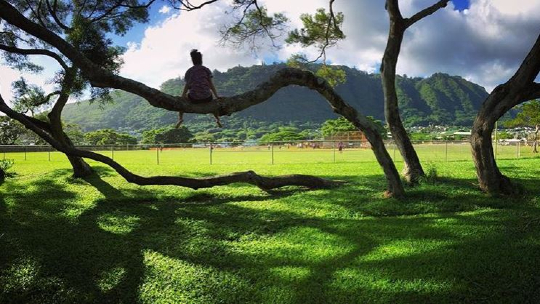
Enjoying some shade at Manoa Valley District Park. Courtesy Trees for Honolulu's Future
The nonprofit organization’s goal is to get the word out through education and outreach. Part of that is encouraging immediate action.
“When you plant a tree, it’s not instant canopy. It takes years for the tree to grow, but if you don’t plant the tree now, you’ll never get there,” says Dinell, who is currently leading by example. He and his wife recently planted a lemon tree in their yard to go along with their ulu tree.
“Our idea is to create a mini food forest,” he says. “Not just for us, but for our community, too. When you have excess fruit, you take it to the office, you give it to your neighbors and friends. That’s another power of trees: community building.”
New greenery
Come along to Maili Community Park for a look at the new greenery and information on how you can help protect Hawaii’s trees:

